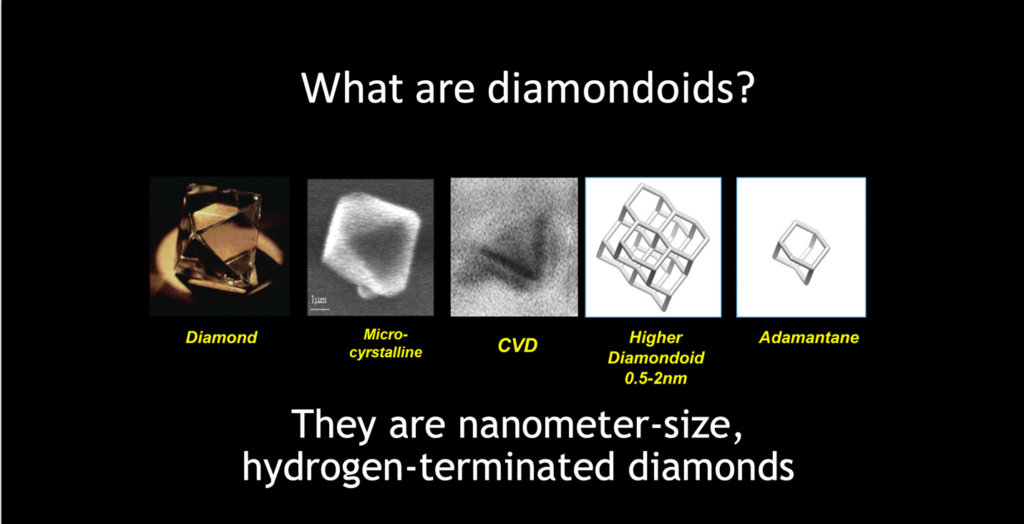Diamondoids: A Petroleum Scientist’s Best Friend Vol I
This week, we are showcasing a slightly older technology we developed and continue to perfect: Quantitative Diamondoid Analysis (QDA). First described in Dahl et al. (1999), this method revolutionized the ability to estimate oil cracking and identify oils derived from more than one source.
Diamondoids are basically molecular-sized diamonds. A diamondoid consisting of a single cage is known as an adamantane, while two cages make up a diamantane, three a triamantane and four a tetramantane, etc. Diamondoids retain many of the properties of diamonds, such as thermal stability when compared to the rest of the petroleum biomarkers, which has tremendous use due to their interlocking cage structure.

Although most oil correlations in publications and company studies had previously only been able to recognize the oil-window source, usually based on biomarker correlations, it turns out that many, and perhaps most, oils are actually mixtures of oil-window and more mature sources. This is true even if the more mature source in the mixture is the dominant component. As such, identification of mixtures and estimates of relative contributions using QDA can drastically change petroleum basin modeling outputs and provide an entirely new view of even the most highly explored basin.

Here we would like to highlight a QDA study of the deep-water Sergipe and Santos basins, where cracked and mixed-source oils are common even in the largest fields, such as Barra (deep-water Sergipe) and Lula (deep-water Santos). Mapping QDA results in both basins provided new insights into migration routes, which in turn could then be related to the CO2 concentrations in the reservoirs, as was the case in the Lula field (Figure 3).
QDA also provides information regarding the filling of individual fields. For example, some wells in Lula produce a single-sourced oil of oil-window maturity, while others produce mixed-source oils from both the same oil-window source and a much deeper and highly mature source. Not only does this suggest different migration routes into different parts of the field, it also indicates that the field is compartmentalized with respect to fluid flow. In addition, the QDA results pointed to the highly-mature charge component of the mix being expelled at vitrinite reflectance values of around 1.4 to 1.5 %Ro, which indicates that there is a source rock generation pod in the basin that could surpass 10,000 meters in depth (Figure 3 and Table 1).
In the deep waters of the Sergipe Basin, although the Barra field oils are classified as Albian-Cenomanian marine condensates with API ranging from 36 to 48 degrees, they present QDA data indicating they are mixtures of non-cracked black oil with dominantly (over 80%) highly-cracked lacustrine condensates/gas from very deep Aptian to Barremian source rocks. In addition, based on the QDA results, it is estimated that the highly mature charge component of the mix in the field was expelled at vitrinite reflectance values of around 1.9 %Ro, indicating there is a lacustrine source rock generation pod in the Mosqueiro Low that could surpass 9,000 meters in depth (Figure 3 and Table 1).
Most deep sources such as Aptian to Barremian lacustrine have not previously been recognized in the Mosqueiro Low in the deep-water province of the Sergipe Basin, as they were invisible to classical geochemical methods.


In conclusion, the application of proprietary AGT developed by BTI/BPS based on integration of diamondoid (QDA), specific isotopes of biomarkers (CSIA-Bh) and extended diamondoid concentrations (QEDA) broke the marine paradigm in the Sergipe-Alagoas Basin, changing the exploration game in the deep-water province.
Moreover, the exploration implications of these new QDA results from the Santos Basin are also immense, especially because they confirm a prolific source in a region of high exploration interest where one was not previously known to exist.
Home / Diamondoids: A Petroleum Scientist’s Best Friend Vol I

